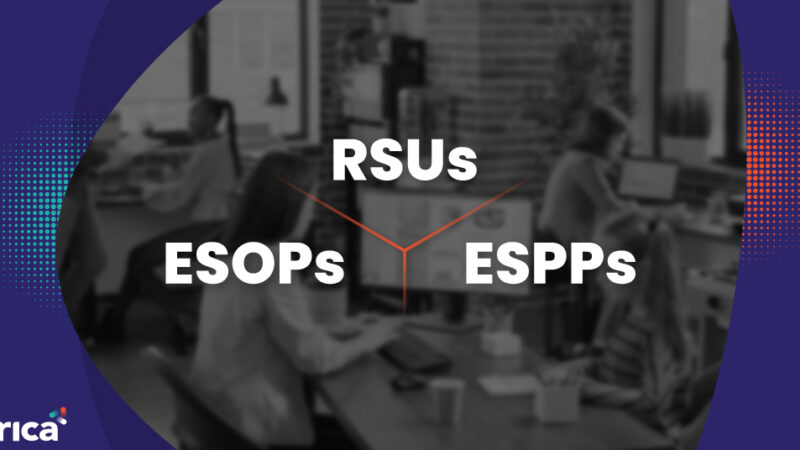
What is Exercise Price?
An ESOP grant gives employees the option to buy shares at a previously defined price.
Now the employee may choose to exercise these options, i.e., to buy these options. Some time is given, and within this time period, the employee needs to exercise their options. Once the employee decides to buy, stock options are allotted at an exercise price that is usually lower than the stock’s Fair Market Value (FMV). An equity option gets its value from the difference between the fixed exercise price and the FMV of the underlying security.
The exercise price of options can be anything chosen by the company while giving out the ESOP grant letter. Some startups choose the exercise price as a nominal amount (say 10 Rs), while others choose the exercise price based upon the last round valuation of the company. Suppose at a later date there is a liquidity event, which gives the options some real value. In that case, it could be argued that the difference in the value of the company from when the employee joined to the liquidity event represents the added value to the company to which they contributed.
What should be the exercise price/strike price of an Employee Stock Option?
The price at which a stock option is exercised is determined by the ESOP’s purpose. It is called the exercise price. ESOPs can be issued depending on a number of factors by different companies. In fact, even within the same company, the exercise price may vary since the company may award ESOPs to various employees with different objectives in mind.
Remuneration Lower than the Market Level
Suppose you provide ESOP benefits to your employees in lieu of salary to compensate an employee who has accepted a substantial salary cut and joined a start-up. In that case, it is only fair that the ESOPs be issued to the person at the lowest possible exercise price. In such a case, this typically would b the face value or par value oc the shares. The standard face value is INR 10, but this varies depending on the company. Before deciding on an exercise price, it’s wise to double-check the face value of the company’s equity shares.
Market level remuneration
If your employees are already earning market-rate salaries and the stock options are being given to them as a bonus or incentive, the exercise price of the options needs to be greater.
Will issuing shares at fair market value or INR 100 per share (issue shares at fair market value) be an unjust exercise price for employees? No, it is not unfair. This is because the employee is unlikely to purchase the stock right away. According to the vesting schedule, the employee can only purchase shares on the vesting date, which will be after a minimum of one year in India (given the mandatory 1 year cliff period). Hopefully, the fair market value of the company’s shares will have increased by that time. As a result, the ESOP still benefits the employee at the time of exercise because the exercise price discounts the then fair market value of the company’s shares.
Suppose the company is granting ESOPs immediately after a fundraising round, in such a case. In that case, the valuation of shares allocated by investors in that round could be used as a benchmark. Therefore, if the company issued shares to investors at a price of INR 100 per share, the exercise price could be INR 100 per share or a discount to the fair market value, such as INR 80 per share.
Calls vs Puts
What Are Options?
Options are derivative contracts with no intrinsic value and whose value is derived from the value of the underlying asset. Shares, currencies, commodities, and other assets can be used as the underlying asset.
An options contract offers the buyer the right, however not the duty, to buy or sell the underlying asset at a given price (referred to as the strike price) and within a specified time frame (referred to as the expiration date).
In the case of options, the buyer of the option has the opportunity to exercise it or cancel it. The option buyer’s loss is only to the extent of the premium paid.
Types of Options
The two primary forms of options available in the derivatives market are call and put options. When you anticipate prices to increase, you should use the Call option. When you anticipate prices to decline or fall, you use a Put option.
Difference Between Call Option and Put Option
Meaning: The buyer has the right to buy a call option, however, not the obligation to do so. The buyer of a put option has the choice to sell, however, not the obligation to do so.
Investors’ expectation: The buyer of a call option anticipates that the stock price will rise/increase. The buyer of a put option anticipates the stock price will fall/decline.
Gains and losses: The advantages for a call option buyer are limitless. The gains for a put option buyer are limited because the stock prices will not fall to zero. The loss of a call option buyer is limited to the premium paid. The maximum loss for a put option seller is the strike price minus the premium.
Dividend reaction: As the dividend date approaches, calls lose value. Puts gain in value as the dividend dates approach.
Example
The current price or spot price of ABCD Inc., on 7th October 2021 is INR 1,935.75 and its INR 2,000 call option expiring on 30th November 2021 is currently available at INR 67.25. 1 lot of ABCD Inc., the option contract is 605 shares.
So, in the above call option example:
Spot price – INR 1,935.75
Strike price (Following a specific amount of time, the price at which buyers & sellers decide to buy/sell the underlying asset.) INR 2,000
Option premium (The non-refundable payment paid upfront by the option buyer to the option seller is known as the option premium) INR 67. 25
Expiry – 31st December 2020
Lot Size – 605 shares
When to purchase the call option: If the buyer anticipates ABCD Inc., the stock price will go up to INR 2,000.
When to exercise the call option: If the share price of ABCD Inc., increases to INR 2,000, the buyer can exercise the call option, wherein case the seller is obligated to sell the buyer 1 lot of ABCD Inc., at INR 2,000 per share because the buyer has paid the seller a premium of Rs 67.25, which binds him to the contract.
When to cancel the call option: The buyer can terminate the contract if ABCD Inc., the share price does not cross INR 2,000 before 30th November 2021 The INR 67.25 paid as premium to the option writer is the loss in that case.
The reason for canceling the deal is simple: why would the buyer purchase ABCD Inc., shares from a vendor for INR 2000 when the buyer can get them for less on the stock market? As a result, the buyer terminates the contract.
Check out trica equity and manage your entire equity stack digitally!
Click here for a blog on the tax outgos of ESOPs!
Disclaimer: This article has been prepared for general guidance on the subject matter and does not constitute professional advice. The matters described herein are general in nature and have not been evaluated based on applicable laws. You should not act upon the information contained in this note without obtaining specific professional advice. No representation or warranty (express or implied) is given as to the accuracy or completeness of the information contained in this note. LetsVenture Technologies Private Limited, its partners, employees, and agents accept no liability and disclaim all responsibility for the consequences of you or anyone else acting or refraining to act in reliance on the information contained in this publication or for any decision based on it. Without prior permission of LetsVenture Technologies Private Limited, this note may not be quoted in whole or in part or otherwise referred to any person or in any documents.
ESOP & CAP Table
Management simplified
Get started for free





